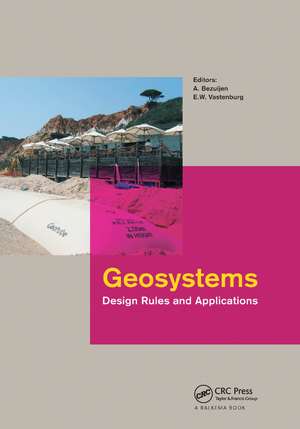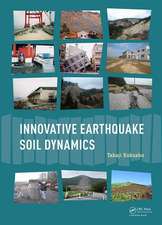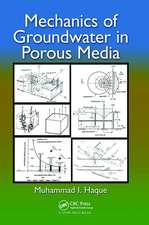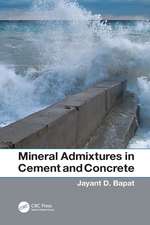Geosystems: Design Rules and Applications
Editat de Adam Bezuijen, E. W. Vastenburgen Limba Engleză Paperback – 23 oct 2019
The use of geosystems has the advantage that local material can be applied and that no (expensive) quarry stone needs to be extracted and transported from the mountains to the site. Compared to traditional construction methods (with quarry stone) the application of geotextile sand filled elements may add considerable operational advantages to the execution of marine works and may offer attractive financial opportunities. In the application of geotextile encapsulated sand elements however, proper attention should be paid to the laying down of different responsibilities of the parties in the contract.
In Geosystems. Design Rules and Applications four types of geotextile sand elements are distinguished, each with specific properties: geo-bags, geo-mattresses, geotextile tubes and geotextile containers. The focus is on the use of geosystems filled with sand as a construction in river and coastal engineering. Geosystems filled with sludge are not covered. The chapters “Introduction” and “General design aspects” are followed by four chapters of the same structure dealing with the various systems. Each of these four chapters starts with a general description and applications and ends with a calculation example. Design aspects are dealt with in the remaining paragraphs.
Geosystems. Design Rules and Applications is based on research commissioned by the Dutch Rijkswa
| Toate formatele și edițiile | Preț | Express |
|---|---|---|
| Paperback (1) | 367.46 lei 43-57 zile | |
| CRC Press – 23 oct 2019 | 367.46 lei 43-57 zile | |
| Hardback (1) | 486.32 lei 43-57 zile | |
| CRC Press – 14 noi 2012 | 486.32 lei 43-57 zile |
Preț: 367.46 lei
Preț vechi: 475.62 lei
-23% Nou
Puncte Express: 551
Preț estimativ în valută:
70.31€ • 73.60$ • 58.52£
70.31€ • 73.60$ • 58.52£
Carte tipărită la comandă
Livrare economică 31 martie-14 aprilie
Preluare comenzi: 021 569.72.76
Specificații
ISBN-13: 9780367380670
ISBN-10: 0367380676
Pagini: 164
Dimensiuni: 174 x 246 mm
Greutate: 0.3 kg
Ediția:1
Editura: CRC Press
Colecția CRC Press
ISBN-10: 0367380676
Pagini: 164
Dimensiuni: 174 x 246 mm
Greutate: 0.3 kg
Ediția:1
Editura: CRC Press
Colecția CRC Press
Public țintă
Academic and Professional Practice & DevelopmentCuprins
Preface Notations List of figures 1 Introduction 1.1 Why there is a need for design rules for geotextile-encapsulated sand elements 1.2 Document structure 2 General design aspects 2.1 Basic principles of geotextile-encapsulated sand elements 2.2 Design approach 2.3 Safety considerations 2.3.1 Introduction 2.3.2 Deterministic method 2.3.3 Potential failure mechanisms 2.4 Material aspects of geotextiles 2.4.1 Raw materials 2.4.2 Sand tightness 2.4.3 Permeability 2.4.4 Tensile strength and strain 2.4.5 Seams 2.4.6 Damage during installation of gravel layers 2.4.7 Durability 2.4.8 CE marking 3 Geotextile bags 3.1 Application sand general experimental data 3.2 Installation procedure 3.3 Geometric design 3.4 Failure modes and safety considerations 3.5 Design aspects 3.5.1 Material choice 3.5.2 Required tensile strength 3.5.3 Stability in waves 3.5.4 Stability when subject to longitudinal current flows 3.5.5 Stability when subject to overtopping currents 3.5.6 Stability of geotextile bags placed in mounds 3.6 Construction aspects 3.7 Calculation example 4 Geotextile mattresses 4.1 Application areas and general experimental data 4.2 Installation procedure 4.3 Geometric design 4.4 Potential failure mechanisms and safety considerations 4.5 Design aspects 4.5.1 Material choice 4.5.2 Required tensile strength 4.5.3 Stability in waves 4.5.4 Stability in longitudinal currents 4.5.5 Geotechnical stability 4.6 Construction aspects 4.7 Calculation example 5 Geotextile tubes 5.1 Applications and general experimental data 5.2 Installation procedure 5.2.1 General 5.2.2 Pump speed and pump capacity 5.2.3 Fill material 5.3 Geometric design 5.4 Failure mechanisms and safety considerations 5.5 Design
Descriere
Geotextile encapsulated sand elements are relatively new, and the number of applications is growing in river and coastal engineering. Compared to traditional construction methods (with quarry stone) the application of geotextile sand filled elements may add considerable operational advantages to the execution of marine works and may offer attractive financial opportunities. In Geosystems. Design Rules and Applications four types of geotextile sand elements are distinguished: geo-bags, geo-mattresses, geotextile tubes and geotextile containers. The book is an essential reference for professionals and academics interested in River and Coastal Engineering, but aims also at those interested in Geotechnical Engineering.










